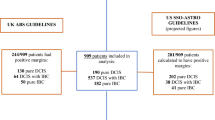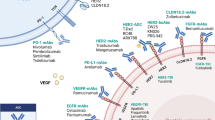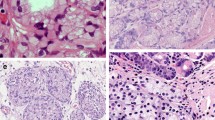Abstract
The importance of tumour microenvironment in tumour behaviour has now become clearer. This study aimed to determine the prognostic effect of the proportion of tumour-stroma (PTS) in metastatic lymph nodes of advanced-stage colon cancers (CCs). We investigated PTS in positive lymph nodes of stage III-IV CC patients who underwent surgical treatment between 2004 and 2014. We used a standard approach in methodology. PTS was significantly associated with prognostic factors in the metastatic lymph nodes (perineural invasion [p = 0.031], lymphatic invasion [p = 0.032], invasive margin [p = 0.043], advanced pT [p = 0.020], and margin involvement [p = 0.034]). In addition, the correlations between PTS estimates (R = 0.704 to 0.617, p < 0.001), the reproducibility of the research (Κappa = 0.72–0.68) and the usefulness of the cut-off value (ROC: 50.33%; AUC = 0.752 [0.667–0.857]) were successful. In univariate analysis, 5-year survival was poor for RFS (p < 0.001), OS (p = 0.001) and LR (p = 0.013) in high PTS patients. Multivariate analysis confirmed that high PTS was an independent worse parameter for RFS (HR = 1.32, 95% CI: 1.17–2.55, p = 0.001) and OS (HR = 1.37, 95% CI: 1.25–1 - 2.56, p = 0.009). In this study, we showed that high PTS in metastatic lymph nodes was a successful prognostic marker for advanced-stage CCs. Also, the standard approach we used for the methodology was successful.




Similar content being viewed by others
Abbreviations
- PTS :
-
Proportion of Tumour Stroma
- CC :
-
Colon cancer
- H&E :
-
Hematoxylin and eosin
- IHC :
-
Immunohistochemistry
- HPF :
-
High-power field
- SD :
-
Standard deviation
- HR :
-
Hazard ratio
- CI :
-
Confidence interval
- ICC :
-
Intra-Class Correlation Coefficient
- K :
-
Kappa
- MSI :
-
Microsatellite instability
- MMR :
-
Mismatch repair proteins
- RFS :
-
Relapse-free survival
- OS :
-
Overall survival
- LR :
-
Local recurrence
- DR :
-
Distant recurrence
- Model A :
-
Using the ‘deepest invasive blocks&hot-spot area & invasive margin’
- Method 1 :
-
Using the ‘×20 objektive&IHC&quantitative’
References
Deijen CL, Vasmel JE, de Lange-de Klerk ESM et al (2017) Ten-year outcomes of a randomised trial of laparoscopic versus open surgery for colon cancer. Surg Endosc 31:2607–2615
Bertelsen CA, Neuenschwander AU, Jansen JE et al (2015) Disease-free survival after complete mesocolic excision compared with conventional colon cancer surgery: a retrospective, population-based study. Lancet Oncol 16:161–168
Ferlay J, Steliarova-Foucher E, Lortet-Tieulent J et al (2013) Cancer incidence and mortality patterns in Europe: estimates for 40 countries in 2012. Eur J Cancer 49:1374–1403
Gray R, Barnwell J, McConkey C et al (2007) Adjuvant chemotherapy versus observation in patients with colorectal cancer: a randomised study. Lancet. 370:2020–2029
Benson AB, Schrag D, Somerfield MR et al (2004) American Society of Clinical Oncology recommendations on adjuvant chemotherapy for stage II colon cancer. J Clin Oncol 22:3408–3419
Langley RR, Fidler IJ (2011) The seed and soil hypothesis revisited--the role of tumour-stroma interactions in metastasis to different organs. Int J Cancer 128:2527–2535
De Wever O, Mareel M (2003) Role of tissue stroma in cancer cell invasion. J Pathol 200:429–447
Quail DF, Joyce JA (2013) Microenvironmental regulation of tumour progression and metastasis. Nat Med 19:1423–1437
Pietras K, Ostman A (2010) Hallmarks of cancer: interactions with the tumour stroma. Exp Cell Res 316:1324–1331
Mesker WE, Junggeburt JM, Szuhai K et al (2007) The carcinoma-stromal ratio of colon carcinoma is an independent factor for survival compared to lymph node status and tumour stage. Cell Oncol 29:387–398
Park JH, Richards CH, McMillan DC (2014) The relationship between tumour stroma percentage, the tumour microenvironment and survival in patients with primary operable colorectal cancer. Ann Oncol 25:644–651
Huijbers A, Tollenaar RA (2013) V Pelt GW, et al. the proportion of tumour-stroma as a strong prognosticator for stage II and III colon cancer patients: validation in the VICTOR trial. Ann Oncol 24:179–185
Mesker WE, Liefers GJ, Junggeburt JM et al (2009) Presence of a high amount of stroma and downregulation of SMAD4 predict for worse survival for stage I-II colon cancer patients. Cell Oncol 31:169–178
Zengin M (2019) Prognostic role of tumor-infiltrating T lymphocytes in stage IIA (T3N0) colon cancer: a broad methodological study in a fairly homogeneous population. Ann Diagn Pathol 41:69–78
Zengin M (2020) Local inflammatory response can predict clinical outcome in patients with curatively resected stage-IIB Colon Cancer: an advanced methodological study. Pathol Oncol Res 26:1805-1816
McShane LM, Altman DG, Sauerbrei W et al (2005) REporting recommendations for tumour MARKer prognostic studies (REMARK). Br J Cancer 93:387–391
Sobin LH, Compton CC (2010) TNM seventh edition: what’s new, what’s changed: communication from the International Union against Cancer and the American joint committee on Cancer. Cancer. 116(22):5336–5339
Eriksen AC, Sørensen FB, Lindebjerg J et al (2018) The prognostic value of tumour stroma ratio and tumour budding in stage II colon cancer. A nationwide population-based study. Int J Color Dis 33(8):1115–1124
Salgado R, Denkert C, Demaria S et al (2015) The evaluation of tumor-infiltrating lymphocytes (TILs) in breast cancer: recommendations by an international TILs working group 2014. Ann Oncol 26:259–271
McGraw KO (1996) Forming inferences about some intraclass correlation coefficient. Psychol Methods 1:30–46
Landis JR, Koch GG (1977) The measurement of observer agreement for categorical data. Biometrics. 33:159–174
West NP, Dattani M, McShane P et al (2020) The proportion of tumour cells is an independent predictor for survival in colorectal cancer patients. Br J Cancer 102(10):1519–1523
Hutchins GGA, Treanor D, Wright A et al (2017) Intra-tumoural stromal morphometry predicts disease recurrence but no a response to 5-fluorouracil—results from the QUASAR trial of colorectal cancer. Histopathology 3:391–404
Hynes SO, Coleman HG, Kelly PJ et al (2017) Back to the future: routine morphological assessment of the tumour microenvironment is prognostic in stage II/III colon cancer in a large population-based study. Histopathology. 71:12–26
van Pelt GW, Hansen TB, Esther B et al (2016) Stroma-high lymph node involvement predicts poor survival more accurately for patients with stage III colon cancer. J Med Surg Pathol 1:116
Moserle L, Casanovas O (2013) Anti-angiogenesis and metastasis: a tumour and stromal cell alliance. J Intern Med 273:128–137
Koukourakis MI, Giatromanolaki A, Harris AL et al (2006) Comparison of metabolic pathways between cancer cells and stromal cells in colorectal carcinomas: a metabolic survival role for tumor-associated stroma. Cancer Res 66:632–637
Guthrie GJ, Roxburgh CS, Richards CH et al (2013) Circulating IL-6 concentrations link tumour necrosis and systemic and local inflammatory responses in patients undergoing resection for colorectal cancer. Br J Cancer 109:131–137
Ueno H, Jones AM, Wilkinson KH et al (2004) Histological categorisation of fibrotic cancer stroma in advanced rectal cancer. Gut. 53:581–586
Lieubeau B, Heymann MF, Henry F et al (1999) Immunomodulatory effects of tumor-associated fibroblasts in colorectal-tumor development. Int J Cancer 81:629–636
Hemmings C (2013) Is carcinoma a mesenchymal disease? The role of the stromal microenvironment in carcinogenesis. Pathology (Phila) 45:371–381
Tsujino T, Seshimo I, Yamamoto H et al (2007) Stromal myofibroblasts predict disease recurrence for colorectal cancer. Clin Cancer Res 13:2082–2090
Acknowledgements
We thank the staff of the Pathology and Internal Medicine Department for their support and assistance.
Funding
This work was supported by Scientific Research Projects Coordination Unit of Kırıkkale University. Project number: 2020/052.
Author information
Authors and Affiliations
Corresponding author
Ethics declarations
Conflict to Interest Statement
Authors do not report any conflicts of interest.
Ethical Standards
The study was carried out at Kırıkkale University and approved by Kırıkkale University Health Research Ethics Committee (2019.11.11). All procedures performed in our study were consistent with the ethical standard of the national/institutional research committee and the 1964 Helsinki declaration and subsequent adjustment.
Additional information
Publisher’s Note
Springer Nature remains neutral with regard to jurisdictional claims in published maps and institutional affiliations.
Highlights
• We have presented a parameter that provides reliable findings in many large studies.
• We created our population quite homogeneously.
• We worked in advanced stage CC, where we encounter most frequently and deaths and relapses are most common.
• Unlike other studies, we examined this parameter in lymph nodes.
• We tried to provide standardization to pathological evaluation methods.
Rights and permissions
About this article
Cite this article
Zengin, M., Benek, S. The Proportion of Tumour-Stroma in Metastatic Lymph Nodes is An Accurately Prognostic Indicator of Poor Survival for Advanced-Stage Colon Cancers. Pathol. Oncol. Res. 26, 2755–2764 (2020). https://doi.org/10.1007/s12253-020-00877-1
Received:
Accepted:
Published:
Issue Date:
DOI: https://doi.org/10.1007/s12253-020-00877-1




